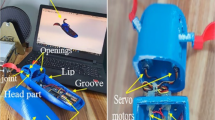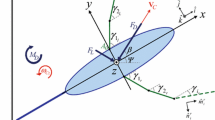Abstract
Fish commonly execute rapid linear accelerations initiated during steady swimming, yet the function of the median fins during this process is less understood. We find that the erection/folding time (from the starting time of the linear acceleration (0 s) to the starting time of the folding movement of the fin), as well as the spreading area of the median fins, actively change during the linear acceleration of the live largemouth bass (Micropterus salmoides). To better understand the influence of the folding time and the area change of the median fins on the linear acceleration, we implemented an undulatory biomimetic robotic fish with soft median fins that can be programmed to erect and fold, just like a live fish. To characterize the acceleration performance of the robotic fish, we developed a “self-propelled” experiment technique based on the Kalman filter and Proportional-Integral-Derivative (PID) control algorithm. The experiments on the robotic fish show the acceleration induced by fully-erected median fins increases by 46.3%. Fully-erected median fins positively contribute to propulsion primarily at the onset stage of the linear acceleration while result in a significant decrease in steady swimming speed by 25%, which suggests a large drag force is induced at the steady swimming stage due to the enlarged wetted area. Parametric sweeping experiments on erection/folding time and spreading area demonstrate a proper combination of the erection/folding time and the spreading area enhances the mean linear acceleration by up to 85%. Particle Image Velocimetry (PIV) results reveal that the vortexes shed by the erected dorsal fin are stronger than those shed by the folded fin. As the acceleration process progresses, the thrust generated by the dorsal fins gradually is weakened until only resistance is generated in the end. Our findings may shed light on the realization of controllable surfaces on high performance fish-inspired robotic systems in the future.
Similar content being viewed by others
Explore related subjects
Discover the latest articles and news from researchers in related subjects, suggested using machine learning.References
Tuna Lab @Large Pelagics. Are Saifish the World’s Fastest Fish in the Ocean? [2015-05-21], https://medium.com/@Tuna/is-sailfish-the-world-s-fastest-fish-in-the-ocean-68c2f7c82779
Tytell E D. Kinematics and hydrodynamics of linear acceleration in eels, Anguilla rostrata. Proceedings of the Royal Society of London. Series B: Biological Sciences, 2004, 271, 2535–2540.
Wise T N, Schwalbe M A B, Tytell E D. Hydrodynamics of linear acceleration in bluegill sunfish, Lepomis macrochirus. Journal of Experimental Biology, 2018, 221, 190892.
Akanyeti O, Putney J, Yanagitsuru Y R, Lauder G V, Liao J C. Accelerating fishes increase propulsive efficiency by modulating vortex ring geometry. Proceedings of the National Academy of Sciences, 2017, 114, 13828–13833.
Wen L, Ren Z Y, Di Santo V, Hu K N, Yuan T, Wang T M, Lauder G V. Understanding fish linear acceleration using an undulatory biorobotic model with soft fluidic elastomer actuated morphing median fins. Soft Robotics, 2018, 5, 375–388.
Jayne B C, Lozada A F, Lauder G V. Function of the dorsal fin in bluegill sunfish: Motor patterns during four distinct locomotor behaviors. Journal of Morphology, 1996, 228, 307–326.
Lauder G V, Nauen J C, Drucker E G. Experimental hydrodynamics and evolution: Function of median fins in ray-finned fishes. Integrative and Comparative Biology, 2002, 42, 1009–1017.
Chadwell B A, Standen E M, Lauder G V, Ashley-Ross M A. Median fin function during the escape response of bluegill sunfish (Lepomis macrochirus). I: Fin-ray orientation and movement. Journal of Experimental Biology, 2012, 215, 2869–2880.
Chadwell B A, Standen E M, Lauder G V, Ashley-Ross M A. Median fin function during the escape response of bluegill sunfish (Lepomis macrochirus). II: Fin-ray curvature. Journal of Experimental Biology, 2012, 215, 2881–2890.
Tytell E D. Median fin function in bluegill sunfish Lepomis macrochirus: Streamwise vortex structure during steady swimming. Journal of Experimental Biology, 2006, 209, 1516–1534.
Maia A, Wilga C A. Function of dorsal fins in bamboo shark during steady swimming. Zoology, 2013, 116, 224–231.
Maia A, Lauder G V, Wilga C D. Hydrodynamic function of dorsal fins in spiny dogfish and bamboo sharks during steady swimming. Journal of Experimental Biology, 2017, 220, 3967–3975
Drucker E G, Lauder G V. Locomotor function of the dorsal fin in teleost fishes: Experimental analysis of wake forces in sunfish. Journal of Experimental Biology, 2001, 204, 2943–2958.
Drucker E G, Lauder G V. Wake dynamics and fluid forces of turning maneuvers in sunfish. Journal of Experimental Biology, 2001, 204, 431–442.
Hove J R, O’Bryan L M, Gordon M S, Webb P W, Weihs D. Boxfishes (Teleostei: Ostraciidae) as a model system for fishes swimming with many fins: Kinematics. Journal of Experimental Biology, 2001, 204, 1459–1471.
Borazjani I. The functional role of caudal and anal/dorsal fins during the C-start of a bluegill sunfish. Journal of Experimental Biology, 2013, 216, 1658–1669.
Standen E M, Lauder G V. Dorsal and anal fin function in bluegill sunfish Lepomis macrochirus: Three-dimensional kinematics during propulsion and maneuvering. Journal of Experimental Biology, 2005, 208, 2753–2763.
Tangorra J L, Lauder G V, Hunter I W, Mittal R, Madden P G, Bozkurttas M. The effect of fin ray flexural rigidity on the propulsive forces generated by a biorobotic fish pectoral fin. Journal of Experimental Biology, 2010, 213, 4043–4054.
Esposito C J, Tangorra J L, Flammang B E, Lauder G V. A robotic fish caudal fin: Effects of stiffness and motor program on locomotor performance. Journal of Experimental Biology, 2012, 215, 56–67.
Wen L, Wang T M, Wu G H, Linag J H, Wang C L. Novel method for the modeling and control investigation of efficient swimming for robotic fish. IEEE Transactions on Industrial Electronics, 2011, 59, 3176–3188.
Zhu J, White C, Wainwright D K, Di Santo V, Lauder G V, Bart-Smith H. Tuna robotics: A high-frequency experimental platform exploring the performance space of swimming fishes. Science Robotics, 2019, 4, eaax4615.
Conte J, Modarres-Sadeghi Y, Watts M N, Hover F S, Triantafyllou M S. A fast-starting mechanical fish that accelerates at 40 m·s−2. Bioinspiration & Biomimetics, 2010, 5, 035004.
Marchese A D, Onal C D, Rus D. Autonomous soft robotic fish capable of escape maneuvers using fluidic elastomer actuators. Soft Robotics, 2014, 1, 75–87.
Borazjani I. Simulations of unsteady aquatic locomotion: From unsteadiness in straight-line swimming to fast-starts. Integrative and Comparative Biology, 2015, 55, 740–752.
Bainbridge R. Speed and stamina in three fish. Journal of Experimental Biology, 1960, 37, 129–153.
Bandyopadhyay P R. Trends in biorobotic autonomous undersea vehicles. IEEE Journal of Oceanic Engineering, 2005, 30, 109–139.
Wu T Y. On theoretical modeling of aquatic and aerial animal locomotion. Advances in Applied Mechanics, 2002, 38, 291–353.
Witt W C, Wen L, Lauder G V. Hydrodynamics of C-start escape responses of fish as studied with simple physical models. Integrative and Comparative Biology, 2015, 55, 728–739.
Feilich K L, Lauder G V. Passive mechanical models of fish caudal fins: Effects of shape and stiffness on self-propulsion. Bioinspiration & Biomimetic, 2015, 10, 036002.
Akanyeti O, Thornycroft P J M, Lauder G V, Yanagitsuru Y R, Peterson A N, Liao J C. Fish optimize sensing and respiration during undulatory swimming. Nature Communications, 2016, 7, 11044
Eaton R C, Bombardieri R A, Meyer D L. The Mauthner-initiated startle response in teleost fish. Journal of Experimental Biology, 1977, 66, 65–81.
Tytell E D, Standen E M, Lauder G V. Escaping Flatland: Three-dimensional kinematics and hydrodynamics of median fins in fishes. Journal of Experimental Biology, 2008, 211, 187–195.
Frith H R, Blake R W. Mechanics of the startle response in the northern pike, Esox lucius. Canadian Journal of Zoology, 1991, 69, 2831–2839.
Webb P W. Effects of median-fin amputation on fast-start performance of rainbow trout (Salmo gairdneri). Journal of Experimental Biology, 1977, 68, 123–135.
Webb P W. Fast-start performance and body form in seven species of teleost fish. Journal of Experimental Biology, 1978, 74, 211–216.
Acknowledgment
This work was supported by the National Science Foundation support projects, China (Grant Nos. 91848105, 61822303, 61633004 and 91848206), in part by National Key R&D Program of China (Grant Nos. 18YFB1304600 and 2019YFB1309600).
Author information
Authors and Affiliations
Corresponding author
Electronic supplementary material
Rights and permissions
About this article
Cite this article
Sun, W., Liu, Z., Ren, Z. et al. Linear Acceleration of an Undulatory Robotic Fish with Dynamic Morphing Median Fin under the Instantaneous Self-propelled Condition. J Bionic Eng 17, 241–253 (2020). https://doi.org/10.1007/s42235-020-0019-2
Published:
Issue Date:
DOI: https://doi.org/10.1007/s42235-020-0019-2




